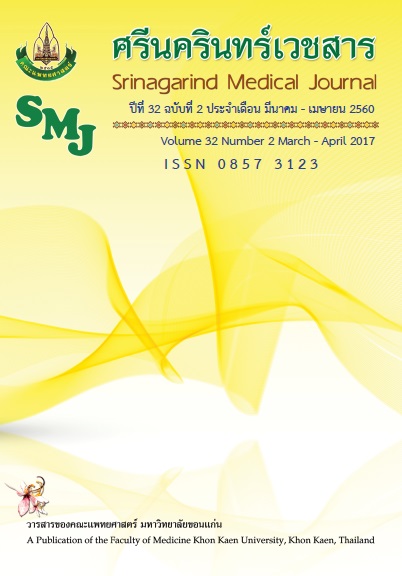The Effect of Applied Plyometric Training Program on Muscle Strength and Muscle Power in Male Thai Boxing Athletes
Keywords:
Male Thai boxing athletes, Applied plyometric training program, Muscle strength,Abstract
Background and objective: Thai boxing or Muaythai is the cultural martial fighting art of Thailand. Thai boxing fight requires strength, speed, power explosive and powerful movements for an athlete to succeed. There is no research study using plyometric training program for development of muscle strength and muscle power in male Thai boxing athletes before. Therefore, the purpose of this study was to investigate the effect of applied plyometric training program on muscle strength and muscle power in male Thai boxing athletes.
Method: Thirty-Three participants of male Thai boxing athletes between the age of 18 to 25 years old were randomly assigned into two group; control group (CG; n = 16) and applied plyometric training group (PTG; n = 17). The CG subjects were practiced normal Thai boxing training program (NTP) 5 days / week, while the PTG subjects trained NTP 5 days / week add with an applied plyometric exercise for 50 minutes / session (10 minutes warm up, 30 minutes applied plyometric exercise of 85 - 100 % HRmax and 10 minutes for cool down) 2 days / week continuously for 12 weeks. All subjects were investigated on their baseline characteristics, anthropometry, muscle strength and muscle power. In this study, isokinetic test was used to determine their muscle strength at speed 60° / sec and muscle power at speed 180° / sec in knee extension, shoulder abduction and elbow flexion (according to Primus RS manual). Comparative analysis of isokinetic parameters were assessed at pre - test period (week1), mid - test period (week7) and post - test period (week 14), consequently.
Results: Baseline characteristics in control group (CG) and applied plyometric training group (PTG) shown no significant differences in age, body weight (BW), body mass index (BMI), blood pressure (BP) and heart rate (HR). Data of isokinetic test in CG shown no significant differences, while the PTG’s data shown increase significant differences. Isokinetic test data in week 14 shown the increase of leg extension by 20.17 % and 35.12 %, of shoulder abduction by 30.82 % and 40.36 %, of elbow flexion by 29.35 % and 39.17 %, at speed Con 60° and Con 180°, consequently in PTG.
Conclusion: Applied plyometric training program could improve physical performance, muscle strength and muscle power after significantly 12 weeks of exercise program in male Thai boxing athletes. This could be a new model of exercise training program on development of physical performance, muscle strength and muscle power for male Thai boxing athletes.
ผลของการฝึกโปรแกรมพลัยโอเมตริกแบบประยุกต์ต่อความแข็งแรงและกำลังของกล้ามเนื้อในนักกีฬามวยไทยชาย
ปรเมษฐ์ วงษ์พุทธิชัย1, ธัญดา สุทธิธรรม2, อภิวันท์ มนิมนากร3, กันยลักษณ์ กิตตินนท์4 ,
1 หลักสูตรวิทยาศาสตร์การออกกำลังกายและการกีฬา บัณฑิตวิทยาลัย มหาวิทยาลัยขอนแก่น
2 -3ภาควิชาสรีรวิทยา คณะแพทยศาสตร์ มหาวิทยาลัยขอนแก่น
4 หน่วยกุมารเวช โรงพยาบาลระนอง
หลักการและวัตถุประสงค์: ไทยบ๊อกซิ่งหรือมวยไทยเป็นศิลปวัฒธรรมการต่อสู้ประจำชาติไทย การชกมวยไทยจำเป็นต้องมีความแข็งแรง ความรวดเร็ว พลังแรงระเบิด และการเคลื่อนไหวที่มีประสิทธิภาพ ถึงจะประสบชัยชนะ การเสริมสร้างความแข็งแรงและพลังกล้ามเนื้อโดยวิธีการฝึกพลัยโอเมตริกในนักกีฬามวยไทยชายยังไม่มีผู้ใดทำการศึกษาวิจัยมาก่อน ดังนั้นวัตถุประสงค์ของการศึกษาครั้งนี้เพื่อศึกษาผลของการฝึกโปรแกรมพลัยโอเมตริกแบบประยุกต์ ต่อความแข็งแรงของกล้ามเนื้อและพลังกล้ามเนื้อในนักกีฬามวยไทยชาย
วิธีการศึกษา: อาสาสมัครนักกีฬามวยไทยชายจำนวน 33 ราย อายุระหว่าง 18 ถึง 25 ปี ถูกคัดเลือกแบบสุ่มให้เป็นกลุ่มควบคุม (16 ราย) และกลุ่มฝึกพลัยโอเมตริกแบบประยุกต์ (17 ราย) ในกลุ่มควบคุมจะถูกฝึกเฉพาะมวยไทยแบบปกติ 5 วัน / สัปดาห์ ขณะที่กลุ่มฝึกพลัยโอเมตริกแบบประยุกต์ จะฝึกมวยไทยแบบปกติ 5 วันต่อสัปดาห์ ร่วมกับการฝึกโปรแกรมพลัยโอเมตริกแบบประยุกต์ 2 วันต่อสัปดาห์, 50 นาที / ครั้ง (10 นาที อบอุ่นร่างกาย, 30 นาที ฝึกพลัยโอเมตริกแบบประยุกต์ ที่ระดับความหนัก 85 - 100 % ของอัตราการเต้นหัวใจสูงสุด, 10 นาที คลายอุ่นกล้ามเนื้อ) ต่อเนื่องกันเป็นเวลา 12 สัปดาห์ อาสาสมัครจะถูกประเมินลักษณะพื้นฐาน การวัดขนาดของร่างกาย ความแข็งแรงของกล้ามเนื้อและพลังกล้ามเนื้อ ในการศึกษาครั้งนี้การทดสอบไอโซคิเนติกซึ่งถูกใช้ในการประเมินความแข็งแรงของกล้ามเนื้อที่ความเร็ว 60° / วินาที และ พลังกล้ามเนื้อที่ความเร็ว 180° / วินาที ในท่าเหยียดเข่า (Knee extension) ท่ายืนกางแขน (Shoulder abduction) และท่างอข้อศอก (Elbow flexion) ในข้างที่ถนัด (ตามคู่มือของ Primus RS) เปรียบเทียบผลระหว่างกลุ่มควบคุมและกลุ่มฝึกพลัยโอเมตริก ก่อนการฝึก (สัปดาห์ที่ 1) ระหว่างการฝึก (สัปดาห์ที่ 7) และหลังการฝึก (สัปดาห์ที่ 14) ตามลำดับ
ผลการศึกษา: การประเมินลักษณะพื้นฐานในกลุ่มควบคุมและกลุ่มฝึกพลัยโอเมตริกแบบประยุกต์ แสดงผลไม่มีความแตกต่างอย่างมีนัยสำคัญทางสถิติของ อายุ น้ำหนักตัว ดัชนีมวลกาย ความดันเลือดและอัตราการเต้นของหัวใจ ผลการทดสอบไอโซคิเนติกในกลุ่มควบคุมไม่มีความแตกต่างกันอย่างมีนัยสำคัญทางสถิติ ในขณะที่ผลการศึกษากลุ่มฝึกพลัยโอเมตริกแบบประยุกต์แสดงผลเพิ่มขึ้นอย่างมีนัยสำคัญทางสถิติ ผลการทดสอบไอโซคิเนติกมีการเพิ่มขึ้นในสัปดาห์ที่ 14 ดังนี้ 20.17 % และ 35.12 % ของท่าเหยียดเข่า (knee extension), 30.82 % และ 40.36 % ของท่ายืนกางแขน (shoulder abduction), 29.35 % และ 39.17 % ของท่างอข้อศอก (elbow flexion) ที่ความเร็วกล้ามเนื้อหดตัว 60 องศาต่อวินาที และความเร็วกล้ามเนื้อหดตัว 180 องศาต่อวินาที ตามลำดับ ในกลุ่มฝึกพลัยโอเมตริก
สรุป: หลังจาก 12 สัปดาห์ของการฝึกโปรแกรมพลัยโอเมตริกแบบประยุกต์ สามารถพัฒนาสมรรถภาพทางกาย ความแข็งแรงของกล้ามเนื้อ และพลังกล้ามเนื้อในนักกีฬามวยไทยชายได้ ดังนั้นการฝึกนี้อาจใช้เป็นโปรแกรมการออกกำลังกายรูปแบบใหม่ที่มีผลต่อการพัฒนาสมรรถภาพทางกาย ความแข็งแรงของกล้ามเนื้อและพลังกล้ามเนื้อในนักกีฬามวยไทยได้




